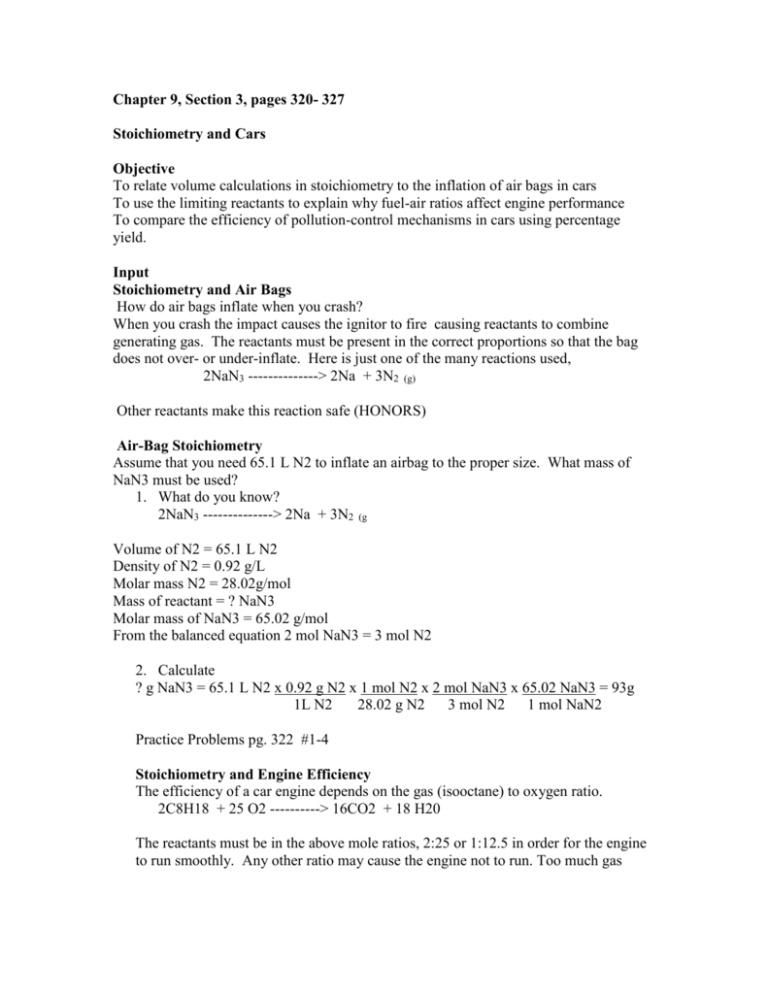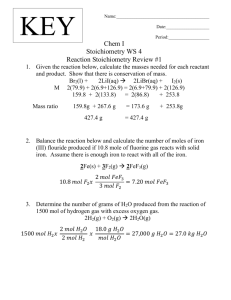Chapter 9, St. 3
advertisement

Chapter 9, Section 3, pages 320- 327 Stoichiometry and Cars Objective To relate volume calculations in stoichiometry to the inflation of air bags in cars To use the limiting reactants to explain why fuel-air ratios affect engine performance To compare the efficiency of pollution-control mechanisms in cars using percentage yield. Input Stoichiometry and Air Bags How do air bags inflate when you crash? When you crash the impact causes the ignitor to fire causing reactants to combine generating gas. The reactants must be present in the correct proportions so that the bag does not over- or under-inflate. Here is just one of the many reactions used, 2NaN3 --------------> 2Na + 3N2 (g) Other reactants make this reaction safe (HONORS) Air-Bag Stoichiometry Assume that you need 65.1 L N2 to inflate an airbag to the proper size. What mass of NaN3 must be used? 1. What do you know? 2NaN3 --------------> 2Na + 3N2 (g Volume of N2 = 65.1 L N2 Density of N2 = 0.92 g/L Molar mass N2 = 28.02g/mol Mass of reactant = ? NaN3 Molar mass of NaN3 = 65.02 g/mol From the balanced equation 2 mol NaN3 = 3 mol N2 2. Calculate ? g NaN3 = 65.1 L N2 x 0.92 g N2 x 1 mol N2 x 2 mol NaN3 x 65.02 NaN3 = 93g 1L N2 28.02 g N2 3 mol N2 1 mol NaN2 Practice Problems pg. 322 #1-4 Stoichiometry and Engine Efficiency The efficiency of a car engine depends on the gas (isooctane) to oxygen ratio. 2C8H18 + 25 O2 ----------> 16CO2 + 18 H20 The reactants must be in the above mole ratios, 2:25 or 1:12.5 in order for the engine to run smoothly. Any other ratio may cause the engine not to run. Too much gas engine “floods”, too little gas will stall. Remember that the amount of O2 in the air is only 21%. Air-Fuel Ratio A cylinder in a car draws 0.5 L of air. How many ml. of isooctane shouid be injected into the cylinder to completely react with the oxygen present? (Density isooctane = 0.692 g/ml and oxygen = 1.33g/ml. Air is 21% oxygen by volume) 1. What do you know? 2C8H18 + 25 O2 ----------> 16CO2 + 18 H20 volume of air = 0.5 L Percettage by volume = 21% Molar mass O2 = 32g/mol. C8H18 = 114.26g/mol 2 Plan you r work—need to know ml. of iso so you need to know moles of oxygen 3. Calculate ? mol O2=0.5 L air x 21 L O2 x 1.33g O2 x 1 mol O2 = 0.00436 mol O2 100L air 1L O2 32g O2 ? ml C8H18 =0.0046 x 2 mol C8H18 x 114.26g C8H18 x 1 ml C8H18 = 5.76 x 10 -2 25 mol )2 1 mol C8H18 0.692g C8H18 Practice Problems pg. 324, #1-3 Stoichiometry and Pollution Control Read yourself. This will not be covered in class. Conclusion Review key concepts. Homework Handout to be given out in class







